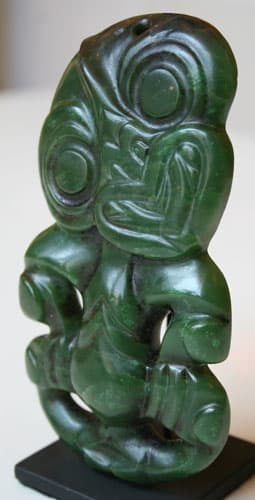Maori Greenstone Hei Tiki Amulet, 17th Century CE - 19th Century CE
2.5 x 5
CK.0874
Further images
Hei Tiki amulets such as this one have become an iconic emblem of both the Maori people, who settled New Zealand around 1000 A.D., and the modern island nation as...
Hei Tiki amulets such as this one have become an iconic emblem of both the Maori people, who settled New Zealand around 1000 A.D., and the modern island nation as a whole. Although they are well-known today, their origins are obscure and their meaning remains debatable. The Maori word “hei” refers to any ornament worn around the neck, while the term “tiki” applies more generally to carved human figures made throughout Polynesia. Tiki is also the name of the first human in Maori mythology. The prevailing theory regarding the meaning of these amulets is that they are depictions of this first man. Another theory, due in large part to their form, is that they symbolize human embryos and, as such, should only be worn by women. However, this contention is contradicted by the fact that early European visitors to New Zealand recorded both men and women wearing such talismans. It is quite possible that the squat form of the figure is a byproduct of the density of the stone and the difficulty of carving and not a conscious effort on the part of the artist to depict a fetus. Hei tiki exist not only in jade, but also in a variety of other precious materials including bone and ivory. In all cases, the inherent value of the materials used imply that tiki were prestige objects, worn by the elite of Maori society and likely passed down from generation to generation. This assertion is reinforced by the fact that in some cases the suspension perforations have been worn through, implying usage beyond that of a single lifespan.





